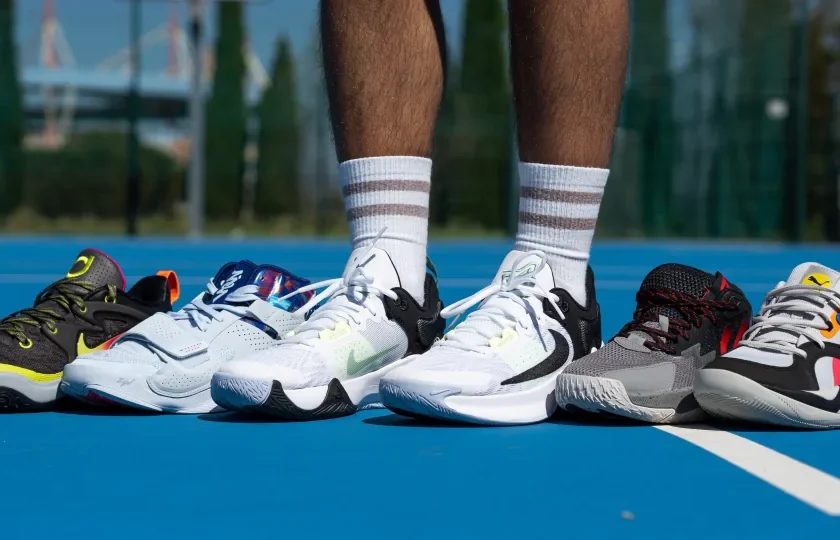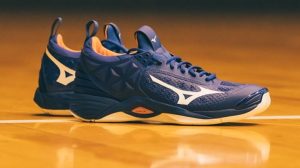Basketball is a sport that requires a lot of speed, agility, and explosiveness. To perform well on the court, you need shoes that are comfortable, durable, and supportive. But you also need shoes that are light, so you can move faster and jump higher without feeling weighed down.
Lightweight basketball shoes are shoes that are designed to reduce the weight and bulkiness of traditional basketball shoes, while still providing the necessary features and functions for the game. Lightweight basketball shoes can help you improve your performance, prevent injuries, and enhance your style.
But how do you choose the best lightweight basketball shoes for your needs? There are many factors to consider, such as the material, the fit, the cushioning, the traction, and the style. In this article, we will explain each of these factors and give you some tips on how to find the perfect pair of lightweight basketball shoes for you.
Material
The material of your basketball shoes affects their weight, durability, breathability, and comfort. You want to avoid materials that are heavy, stiff, or prone to tearing, such as leather, rubber, or canvas. Instead, you want to look for materials that are light, flexible, and resistant to wear and tear, such as synthetic fabrics, mesh, or foam.
Synthetic fabrics are materials that are made of man-made fibers, such as nylon, polyester, or elastane. These materials are durable, breathable, and moisture-wicking, meaning they can keep your feet dry and cool. They also retain their shape and elasticity better than natural materials, such as cotton or wool.
Mesh is a type of synthetic fabric that has small holes or gaps that allow air to flow through. Mesh is very light and breathable, and it can also provide some stretch and support to your feet. However, mesh can also be less durable and protective than other materials, so you may want to look for shoes that have mesh only on certain areas, such as the upper or the tongue.
Foam is a material that is made of air-filled bubbles that can provide cushioning, shock absorption, and support to your feet. Foam is very light and comfortable, and it can also mold to the shape of your feet. However, foam can also be less stable and responsive than other materials, so you may want to look for shoes that have foam only on certain areas, such as the midsole or the heel.
Fit
The fit of your basketball shoes affects their comfort, stability, and performance. You want to avoid shoes that are too tight or too loose, as they can cause blisters, pain, or injuries. Instead, you want to look for shoes that fit snugly and securely, but also allow some room for movement and expansion.
To find the right fit for your basketball shoes, you need to measure your feet correctly and compare them with the size chart of the shoes you want to buy. You can measure your feet by tracing their outline on a piece of paper and measuring the length and width of the outline. You can also try on the shoes before buying them and check for the following signs of a good fit:
- There should be about a thumb’s width of space between your longest toe and the end of the shoe. This will allow your feet to expand and contract during the game and prevent your toes from hitting the shoe.
- The shoes should hug your feet without squeezing them. You should be able to wiggle your toes and move your feet freely. The shoes should also not slip off your heels or slide around your feet. You should be able to lace up the shoes securely and adjust the tightness as needed.
- The shoes should feel comfortable and supportive on your feet and ankles. They should provide enough cushioning and shock absorption for your movements. They should also provide enough traction and stability for your cuts and pivots.
Cushioning
The cushioning of your basketball shoes affects their comfort, shock absorption, and responsiveness. You want to avoid shoes that are too hard or too soft, as they can cause discomfort or injuries. Instead, you want to look for shoes that have the right amount and type of cushioning for your needs.
The amount of cushioning you need depends on your playing style, position, and preference. If you are a fast and agile player who relies on quick and explosive movements, you may want to look for shoes that have less cushioning and more responsiveness. This will allow you to feel the court better and react faster. If you are a powerful and heavy player who relies on strength and impact, you may want to look for shoes that have more cushioning and shock absorption. This will protect your feet and joints from the stress and pressure of the game.
The type of cushioning you need depends on the material and technology of the shoes. There are many types of cushioning available, such as foam, air, gel, or springs. Each type has its own advantages and disadvantages, such as weight, durability, comfort, and performance. Some of the most common types of cushioning are:
-
Foam:
foam is a material that is made of air-filled bubbles that can provide cushioning, shock absorption, and support to your feet. Foam is very light and comfortable, and it can also mold to the shape of your feet. However, foam can also be less stable and responsive than other materials, and it can also lose its shape and elasticity over time. Some examples of foam cushioning are EVA, Phylon, Bounce, and Boost.
-
Air:
Air is a material that is made of pressurized gas that can provide cushioning, shock absorption, and responsiveness to your feet. Air is very light and responsive, and it can also adjust to the pressure and impact of your movements. However, air can also be less durable and protective than other materials, and it can also leak or burst if punctured. Some examples of air cushioning are Air Max, Zoom Air, and Air Sole.
-
Gel:
Gel is a material that is made of a viscous liquid that can provide cushioning, shock absorption, and stability to your feet. Gel is very durable and protective, and it can also distribute the impact evenly across your feet. However, gel can also be heavier and less responsive than other materials, and it can also harden or soften depending on the temperature. Some examples of gel cushioning are Gel, GEL-Kayano, and GEL-Nimbus.
-
Springs:
Springs are a material that is made of coiled metal that can provide cushioning, shock absorption, and bounce to your feet. Springs are very responsive and bouncy, and they can also return the energy of your movements. However, springs can also be heavier and less stable than other materials, and they can also make noise or break if overused. Some examples of spring cushioning are Shox, Springblade, and Joyride.
Traction
The traction of your basketball shoes affects their grip, stability, and performance. You want to avoid shoes that have poor traction, as they can cause you to slip, slide, or fall on the court. Instead, you want to look for shoes that have good traction, so you can move confidently and safely on the court.
The traction of your basketball shoes depends on the design and material of the outsole, which is the bottom part of the shoe that touches the ground. There are many factors that affect the traction of the outsole, such as the pattern, the depth, the width, and the rubber compound. Some of the most common factors are:
- Pattern: The pattern of the outsole refers to the shape and arrangement of the grooves, ridges, or nubs that create friction with the ground. The pattern can affect the grip, flexibility, and durability of the outsole. There are many types of patterns available, such as herringbone, wavy, circular, or multidirectional. Each type has its own advantages and disadvantages, such as traction, versatility, and wear and tear. Generally, the more complex and varied the pattern, the better the traction.
- Depth: The depth of the outsole refers to the thickness and height of the grooves, ridges, or nubs that create friction with the ground. The depth can affect the grip, flexibility, and durability of the outsole. Generally, the deeper the outsole, the better the grip, especially on dusty or dirty courts. However, the deeper the outsole, the less flexible and more prone to wear and tear it is.
- Width: The width of the outsole refers to the distance and spacing between the grooves, ridges, or nubs that create friction with the ground. The width can affect the grip, flexibility, and durability of the outsole. Generally, the wider the outsole, the better the grip, especially on smooth or slippery courts. However, the wider the outsole, the less flexible and more prone to clogging it is.
- Rubber compound: The rubber compound of the outsole refers to the type and quality of the rubber that is used to make the outsole. The rubber compound can affect the grip, flexibility, and durability of the outsole. There are many types of rubber compounds available, such as solid, translucent, sticky, or soft. Each type has its own advantages and disadvantages, such as traction, versatility, and wear and tear. Generally, the softer and stickier the rubber compound, the better the traction, especially on indoor courts. However, the softer and stickier the rubber compound, the less durable and more prone to peeling it is.
Style
The style of your basketball shoes affects their appearance, personality, and fashion. You want to avoid shoes that are dull, boring, or outdated, as they can make you look unattractive, uninteresting, or unfashionable. Instead, you want to look for shoes that are stylish, trendy, and suit your taste and preference. You can also look for shoes that have unique features, such as signature logos, special editions, or custom designs.
Conclusion
Lightweight basketball shoes are shoes that can help you improve your performance, comfort, and style on the court. By choosing the best lightweight basketball shoes for your needs, you can move faster, jump higher, and play better. Remember to consider the material, the fit, the cushioning, the traction, and the style of your shoes, and look for shoes that are light, flexible, durable, supportive, and stylish.


